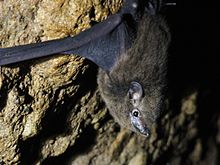
Summary
The Pacific sheath-tailed bat or Polynesian sheath-tailed bat (Emballonura semicaudata) is a species of sac-winged bat in the family Emballonuridae[2] found in American Samoa, Fiji, Guam, Micronesia, Palau, Samoa (where it is called pe'a vai, tagiti or pe'ape'a vai), Tonga, and Vanuatu. Its natural habitat is caves.
| Pacific sheath-tailed bat | |
|---|---|

| |
| Scientific classification | |
| Domain: | Eukaryota |
| Kingdom: | Animalia |
| Phylum: | Chordata |
| Class: | Mammalia |
| Order: | Chiroptera |
| Family: | Emballonuridae |
| Genus: | Emballonura |
| Species: | E. semicaudata
|
| Binomial name | |
| Emballonura semicaudata Peale, 1848
| |

| |
| Pacific sheath-tailed bat range (red — extant, black — extinct) | |
In 2013, Bat Conservation International listed this species as one of the 35 species on its worldwide priority list for conservation.[3] It is threatened by habitat loss. There are estimated to be approximately 500 individuals of the subspecies E. s. rotensis.[4] Currently known to roost in only three caves, E. s. rotensis is vulnerable to changes in the local habitat, including indirect impacts caused by invasive species such as goats[4] which limit its carrying capacity.
References edit
- ^ Waldien, D.L.; Scanlon, A. (2021). "Emballonura semicaudata". IUCN Red List of Threatened Species. 2021: e.T7669A22135085. doi:10.2305/IUCN.UK.2021-1.RLTS.T7669A22135085.en. Retrieved 14 November 2021.
- ^ Simmons, N.B. (2005). "Order Chiroptera". In Wilson, D.E.; Reeder, D.M (eds.). Mammal Species of the World: A Taxonomic and Geographic Reference (3rd ed.). Johns Hopkins University Press. pp. 312–529. ISBN 978-0-8018-8221-0. OCLC 62265494.
- ^ "Annual Report 2013-2014" (PDF). batcon.org. Bat Conservation International. August 2014. Archived from the original (PDF) on July 7, 2017. Retrieved May 1, 2017.
- ^ a b Welch, Jessica Nicole; Fordyce, James A.; Simberloff, Daniel S. (2016-09-01). "Indirect impacts of invaders: A case study of the Pacific sheath-tailed bat (Emballonura semicaudata rotensis)". Biological Conservation. 201: 146–151. doi:10.1016/j.biocon.2016.07.004. ISSN 0006-3207.



